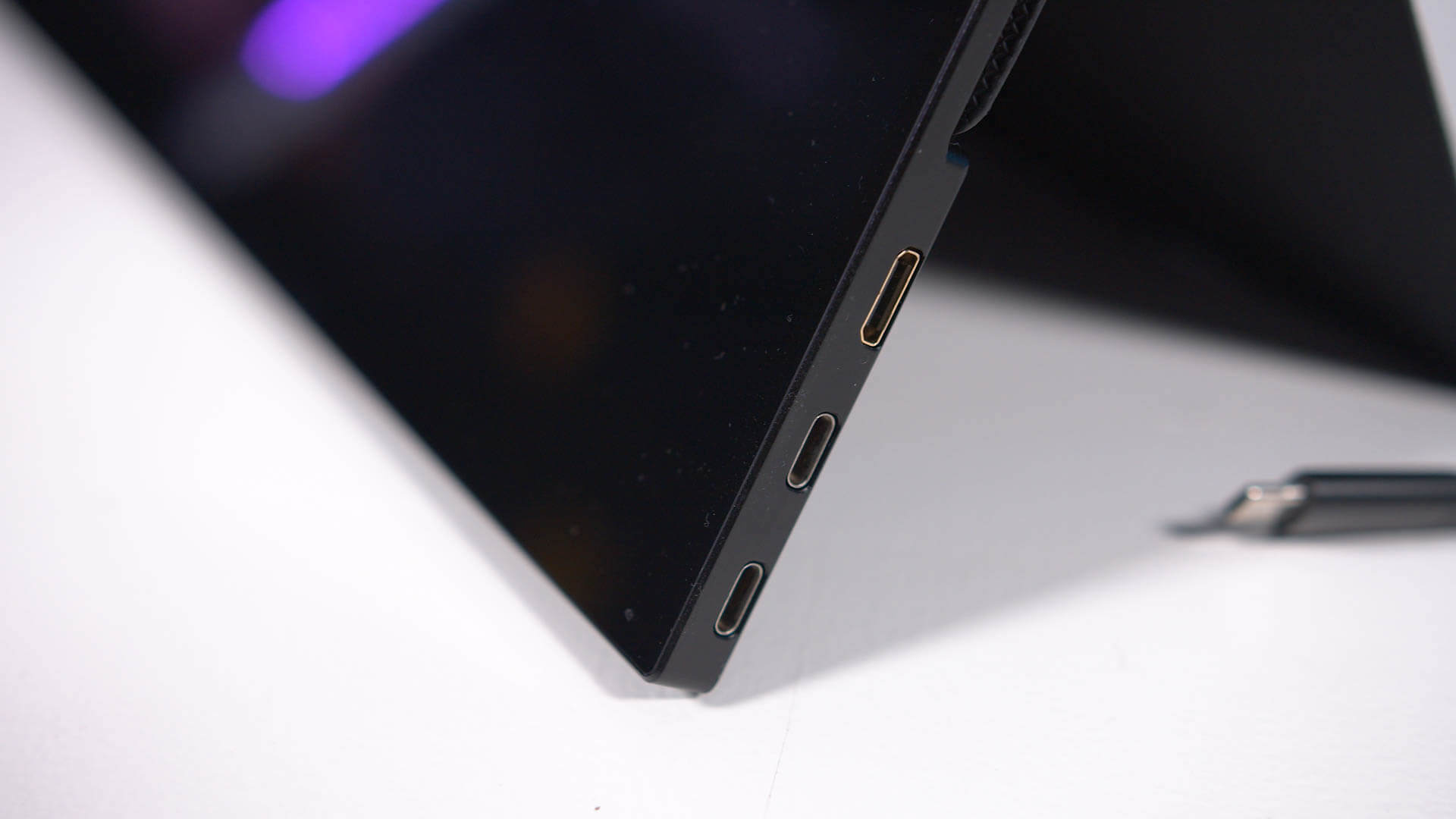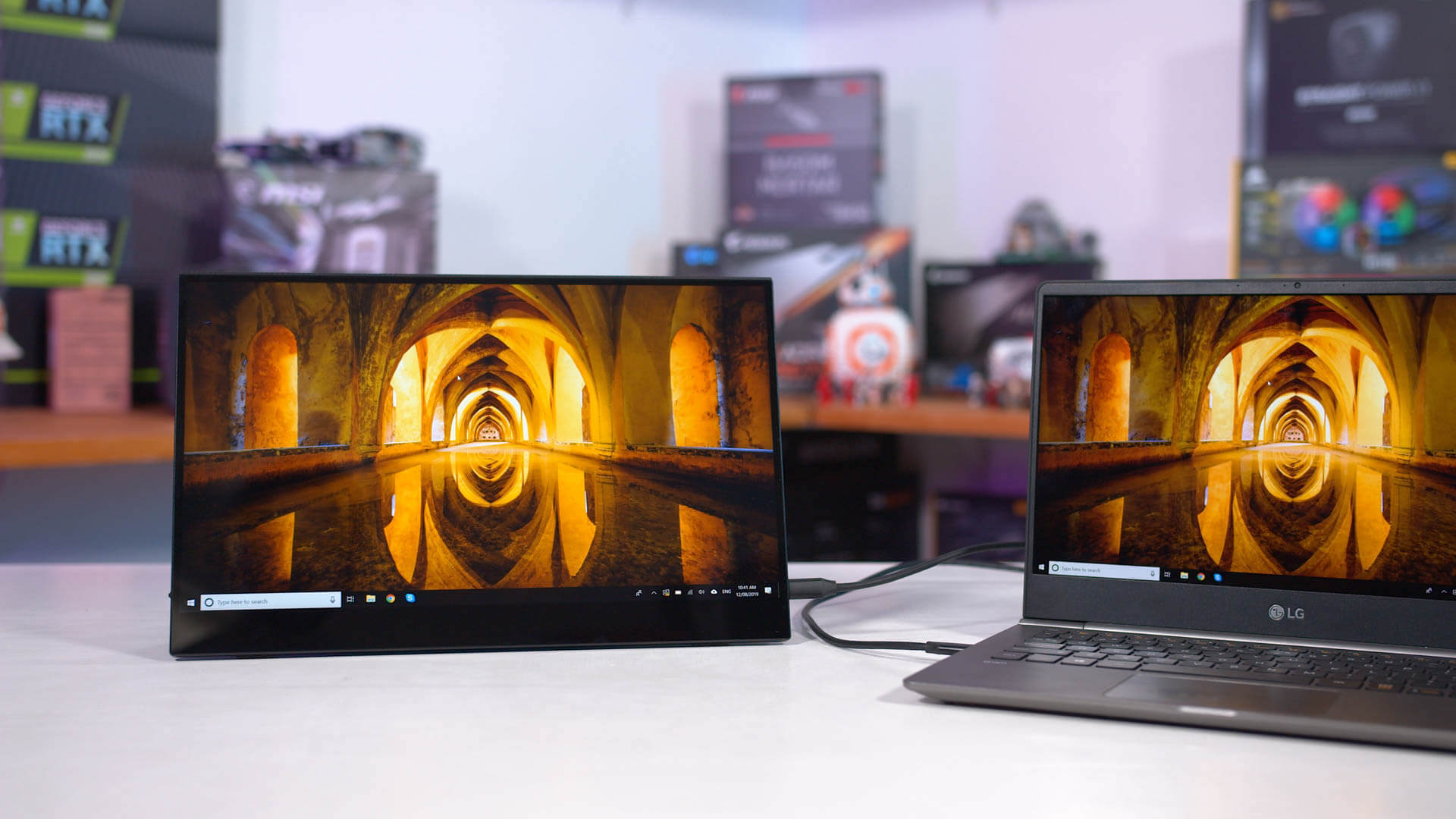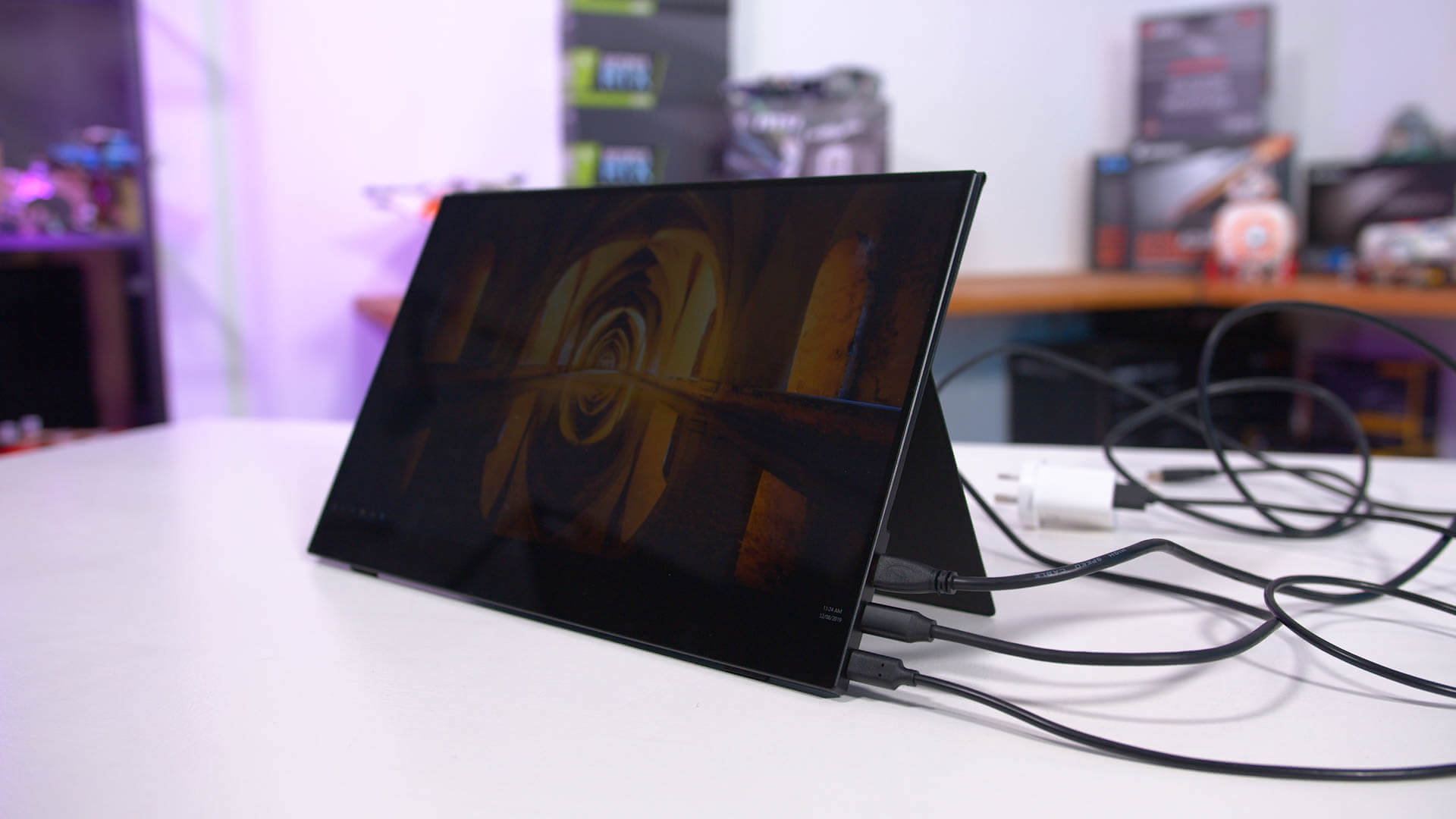The Viotek LinQ Touch is a portable touchscreen monitor that you can use in a number of scenarios. The 15.6-inch 1080p IPS display runs at 60 Hz and is integrated into a light chassis. It's slim enough to slip inside a backpack along with a laptop or other device, and the idea is you could use this as a secondary monitor or a larger display while on the go.
For example, you can hook it up to a laptop for a dual-screen setup, or a console like the Nintendo Switch for a larger display, or even a smartphone. Overall it seems like a decent concept. We've looked at a few of Viotek's gaming monitors and generally we think they are pretty good, so that got us curious.
The LinQ Touch does live up to being portable. It's 10mm thick which is around the thickness of a tablet, and the touch model weighs around 770 grams. There's also a non-touch variant available which is a little cheaper and lighter but appears to use the same design otherwise. Both come with a nifty magnetic folding stand, which covers the display during transportation and prevents it from getting damaged, while also allowing the monitor to be positioned during use at a number of angles. We didn't expect the stand would support a range of angles so that was a pleasant surprise.
The touchscreen panel we tested is $250 and the non-touch will retail for $190, both will be available on Amazon and other retailers later this month. This isn't going to be the cheapest addition to your portable setup, and it's a little more expensive than some of the no-name options on Amazon right now, but at the same time it's cheaper than something like the Asus Zenscreen Go, for what it's worth.
Design & Connectivity
Design and build quality are pretty good. The thin metal body with glass on the front and rear is sturdy and has very little flex to it, there are slim bezels around three sides with a bit of a chin. The magnetic cover attaches easily and it feels well made with its rubberized finish.
On the downside, Viotek has used a mirror finish in reference to the black glass used on both the front and rear. This is a design trend in phones these days, but it's perhaps not the best choice here. The glossy finish is a fingerprint magnet and having so much glass could present an issue if dropped. The included cover will help some, but even with the cover attached there's still an exposed area on the back.
The setup process for using this portable monitor is either going to be easy or complicated, depending on your host device. There are three ports on the monitor: a mini-HDMI port, a USB-C data port, and a USB-C power port. There's no visual distinction between the ports, you just have to know the top one is for data, and the bottom one for power.
If you have a device that supports DP alt-mode over USB-C, chances are you will be able to use this monitor with just one cable. You plug it in, and all of the display signal, touchscreen data and power are delivered over this cable. Many modern laptops support this sort of communication, and given the display only uses up to 8W of power with 100% brightness, most USB-C ports should be able to provide this.
For devices that can't supply enough power, you'll need to hook up the second USB-C power port to a USB power brick, which is not included. Viotek recommends a 5V/3A charger. This is the configuration you'll need for something like a smartphone, or if you're hooking up over mini-HDMI. The good news is the monitor supports USB Power Delivery 2.0, so the monitor can charge your smartphone or other device in this configuration if you use USB-C DP alt-mode for the display signal.
There's a few other connection oddities, for example if you want to use this with a laptop over HDMI, you'll need to use up to three cables: the HDMI cable for the display signal, a USB-C cable for touchscreen data, and possibly a second USB-C cable if your laptop can't supply enough power over USB. Then for something like a Nintendo Switch, if you use a 5V power source you'll get a 720p signal, whereas if you use a 15V source you'll get 1080p. All up, not the most straightforward setup in some scenarios.
In our case we could use the single-cable setup most of the time which is ideal and worked just fine. No flickering or other issues, and the touchscreen is responsive and accurate. We were hoping this wouldn't be a cheap crappy touchscreen and it's not: it's good quality and it's easy to use with the tablet-like coating on the display.
On the left we have a headphone jack, a power button, and a rocker that controls the on-screen menu. Yes, there's still an OSD with some basic color control and other functionality. There's also built-in speakers... which are really bad.
Output Quality
So far, so good... the LinQ could be an excellent portable monitor for a variety of situations. But where it falls apart, is in the actual display's performance.
The biggest issue by far is the color gamut. Just 65% sRGB coverage is frankly inexcusable for a display sold in 2019. sRGB has been the global color standard for these types of displays for decades, and basically every even remotely decent monitor you see will support near-100% coverage. Even budget products these days. Offering a mere 65% coverage is an unforgiveable mistake.
What this means in practice is undersaturation of colors and a general washed out look. We could maybe forgive this sort of thing on a dirt cheap $200 Chromebook with a 1366 x 768 display, but this is a $250 standalone display. We've tested $100 monitors that deliver full sRGB, so this isn't good enough.
Default Color Performance

Saturation

To make matters worse, we know for a fact there are 15.6-inch 1080p 60Hz IPS panels that provide 100% sRGB coverage, because we've tested plenty of laptops that use them. Now, we don't know what happened during the design process for a product like this, but our first thought is Viotek have cheaped out and chosen a budget panel rather than something decent and that's a real shame.
If not for this big fault we could see this sort of product to come very handy for productivity on the go. Say you wanted to edit videos and get a bit of extra screen real estate, or do some photo editing on a larger monitor. With a low color gamut, this is not possible. Even if you just want to watch movies, they're not going to look their best when the gamut is capped to 65% of the standard SDR spectrum.
Default Greyscale Performance

We could go through and show you all the color performance charts, but the reality is it's never going to be sRGB accurate if it can't show all the colors in the sRGB gamut. Take these saturation sweeps, you can see that we're getting undersaturation and at the top end for say, greens, the dots begin to bunch up at the high chromacity range, where basically the top end values are clipped.
The only area we could correct with calibration is greyscale performance. Out of the box things are a bit wonky, especially the gamma curve, but nothing outrageous. Through calibration we can improve that to a sub-1.0 deltaE and a perfect gamma curve. But again we can move across to saturation sweeps and from the 80% mark or so, we still get intense clipping at the top end. Not great.

The other area of concern is response times. Viotek claims a combined rise and fall time metric of 30ms, which is slow by today's standards. We recorded a grey to grey average of 20.07ms, and it's basically a sea of red in the response time chart. Great that we don't get much overshoot, bad that only 25% of transitions fall within the 16.67ms transition window for 60Hz.

The end result is a lot of ghosting and smearing when viewing anything in motion. Fine for more static content and web browsing or photo editing - if the panel's color performance was good for photo editing - but poor for video playback or gaming. And gaming is one of the advertised use cases... but it's not good. This panel reminds us to the very early IPS monitors that hit the market and were overly slow.
Input lag is also poor, we recorded 31ms of latency from the USB-C output on my RTX 2080. Normally we test with DisplayPort, so there could be a bit of a difference introduced there from using USB-C instead, but still that's not a good number, especially for gaming.


Those would be the two big drawbacks that prevent the monitor from performing well. It does well in the rest of our performance tests: 230 nits from a portable monitor, down to 215 nits when calibratied, we think is quite good considering I normally use my laptop at or below 200 nits. Minimum brightness of 5 nits could be useful for use in a dark room. A contrast ratio of 1100:1 when calibrated, is also above average for an IPS monitor.
Finally we have a look at uniformity, where this monitor also provides decent performance. And when you pair this with excellent viewing angles, we do believe some aspects to the performance are quite promising.

Wrap Up
Now for a lot of products, when we get to this point in the review we end up talking about pros and cons, then the price, and make a value judgment on whether you should buy it. But for this Viotek LinQ Touch monitor, we actually think this is a bad product. Its poor color gamut prevents it from being a decent second screen option for productivity or creative work on the go. And if you were planning on using this as a portable monitor for gaming or moving watching, the undersaturation problem you get from the low gamut is compounded by bad response times. In many ways this display performs like an IPS monitor from ten or more years ago. It's not great.
And this is a real shame because we think the framework of a good product is here. You get decent brightness and contrast, excellent viewing angles, and a good design. It genuinely is a very portable monitor, we can see people easily slipping this into a backpack. When paired with a modern laptop it should work over a single cable. The touchscreen is really good and very responsive, too.
But we just can't get past some of the performance problems, especially given you're forking out $190 for the non-touch model, or $250 for the touchscreen version. That's a lot of money to get a mediocre experience. To make matters worse, we know there are panels that could have been used here that would have fixed at least some of the issues. Whether they weren't used for engineering reasons or cost reasons we're not sure, but it's disappointing
We cannot say whether any competing products offer a true 100% sRGB gamut, which is our sticking point here, because we haven't tested them. But an equivalent model from "Virzen," a company we've never heard of, claims to offer an IPS display with 100% sRGB coverage and 5ms response times. Given it's also cheaper at $170, it may be worth taking a punt on. There are plenty of similar units available through places like Amazon as well.
That's for a non-touch option though. If you're after a touchscreen-enabled unit, then Viotek does offer one of the most affordable options. If the touchscreen is the absolute key feature and you don't really care about anything else then maybe you can consider it. But we still think the flaws here are too serious for the asking price. Whether you're a more casual user or a content creator, we are already looking forward for a LinQ 2.0 that can fix this first experiment's flaws.










